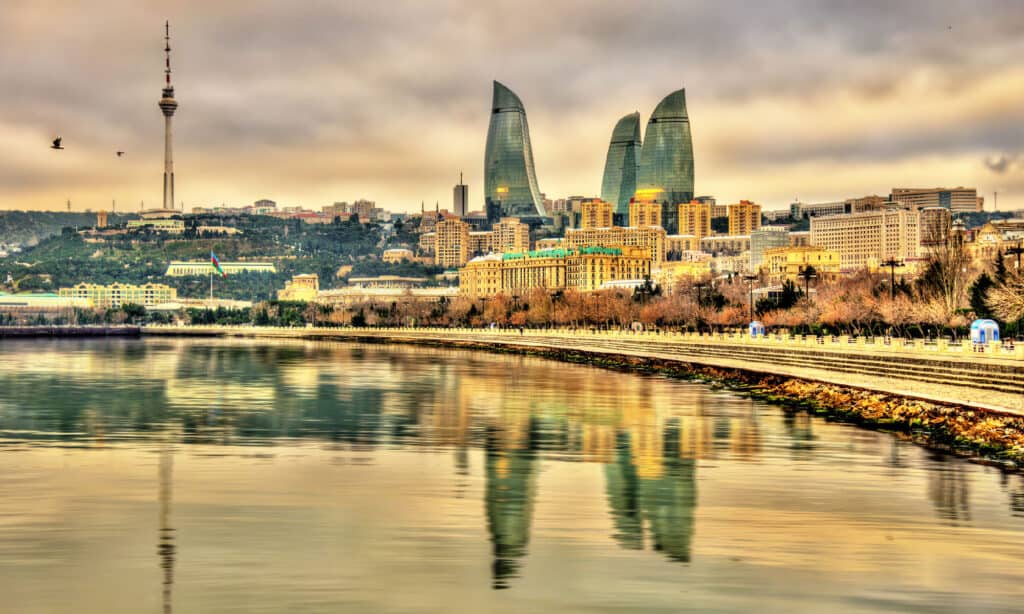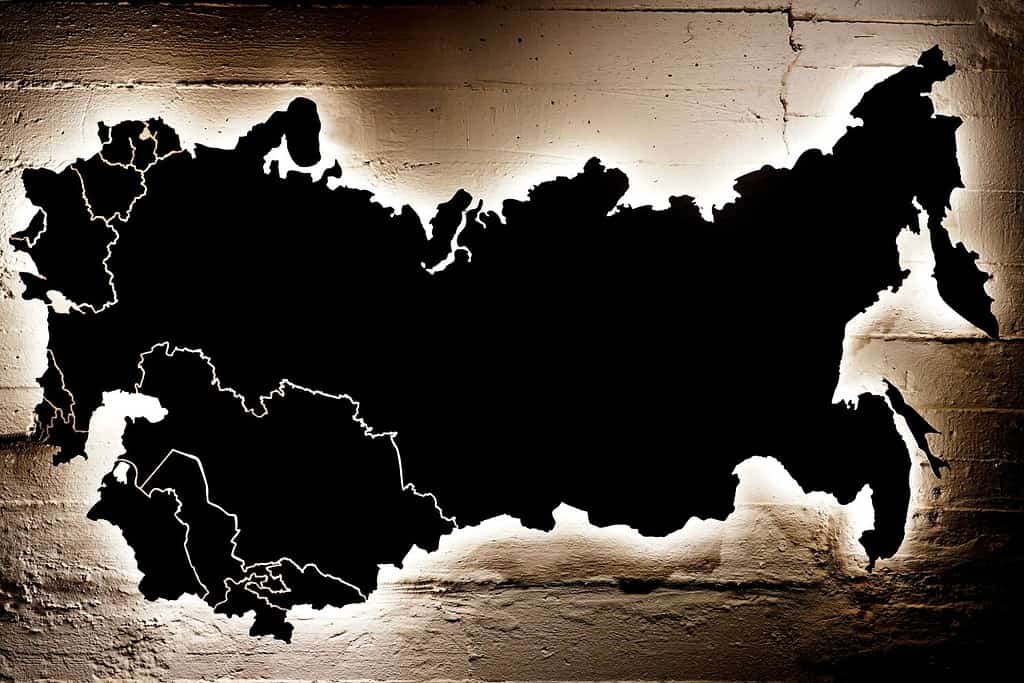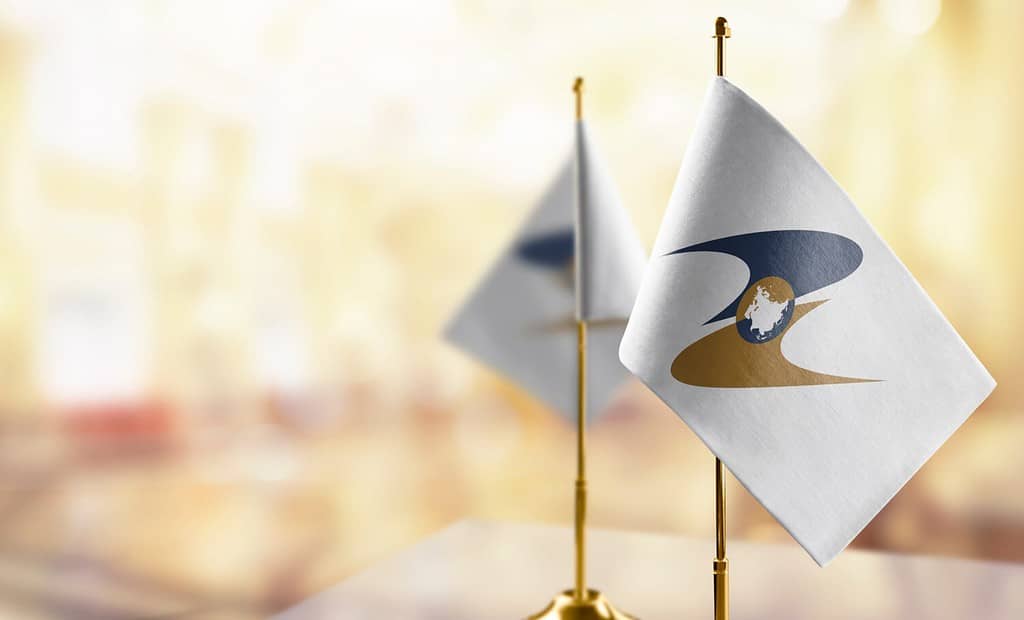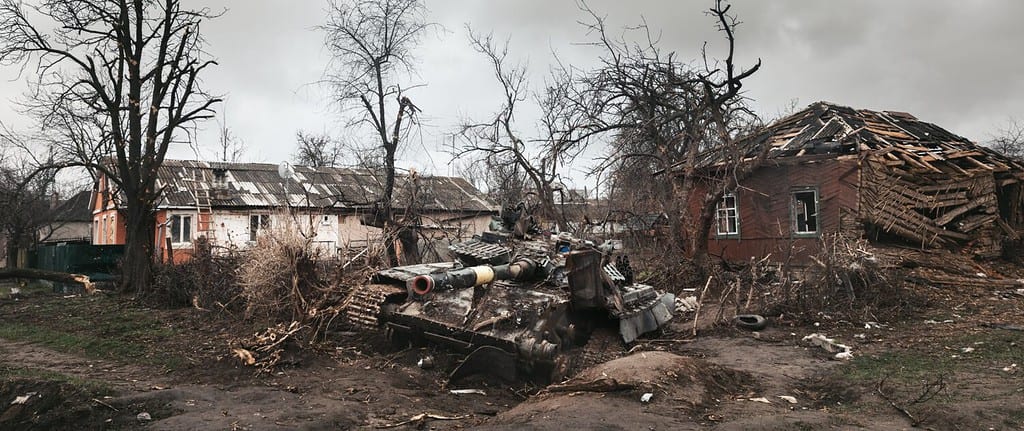“Eurasia” is not a country, but a term describing the whole landmass of Europe and Asia. It’s useful in some conversations because geography doesn’t create a clear division between the two continents. Moreover, some countries, like Russia and Turkey, are located on both continents. Since Eurasia is not a single nation, it doesn’t have an official flag. However, after the breakup of the Soviet Union, some of the newly independent countries formed a replacement organization known as the Commonwealth of Independent States. This organization has its own flag, as does the associated institution, the Eurasian Economic Union. These flags of Eurasia are the topic of this article.

“Eurasia” is a term for the whole landmass of Europe and Asia.
©dikobraziy/ via Getty Images
Where Is the Boundary of Europe?
One of the reasons the term “Eurasia” is useful is due to the fact that no clear boundary between Europe and Asia exists. The Ural Mountains form a decent boundary to the east of Europe, but things get sticky in the southeast. Turkey, for example, is split into two parts, with part on the European side of the Bosphorus Strait, and most of it on the Asian side. So, is Turkey European or Asian? Turkey has been attempting to join the European Union for decades with no success, but it is a member of the Council of Europe and NATO.
Cartographers once used the Caucasus Mountains as a clear European boundary stretching between the Black Sea and the Caspian Sea. Three decades after the breakup of the Soviet Union, though, Georgia, Armenia, and to a lesser extent Azerbaijan, all south of the Caucasus, are culturally and politically aligning with Europe. So, unlike the divisions between other continents, the European-Asian boundary is somewhat fluid and determined by politics more than geography.

Azerbaijan is culturally oriented toward Asia but has economic and political connections with Europe.
©iStock.com/Leonid Andronov
The End of the Soviet Union
Communism collapsed in the Soviet Union in 1991. That year, hardline communists tried to remove reformist President Mikhail Gorbachev from office. Mass protests broke out and the various republics of the Soviet Union began declaring independence. When Russia itself under reformist leader Boris Yeltsin announced its departure, the Soviet Union was doomed as a united country.
Afterward, though, the 15 separate countries born from the Soviet Union had to figure out how to coordinate trade, mutual defense, citizenship issues, and more. The supply chains for industrial production had to cross new international borders of countries with separate currencies and different economic policies. Privatization of industries took place in different ways in different countries. There were extra layers of bureaucracy, delays in transporting goods and people across borders, and rebel outbreaks in some areas. The economy declined disastrously, and an already restive public suffered from crushing unemployment and inflation. The video below explains the events that led to the breakup of the country.
The Commonwealth of Independent States
Membership of the CIS
The Commonwealth of Independent States (CIS) formed with a treaty between Russia, Ukraine, and Belarus. Later, all the other former Soviet Republics besides the Baltic States (Estonia, Latvia, and Lithuania) joined the organization. Georgia left the organization in 2008 after Russia invaded it. Ukraine withdrew in 2018, and Moldova did in 2023. This leaves the CIS with nine remaining members: Russia, Belarus, Armenia, Azerbaijan, Kazakhstan, Kyrgyzstan, Uzbekistan, Tajikistan, and Turkmenistan (an Associate Member).

The breakup of the Soviet Union in 1991 resulted in the creation of 15 independent nations.
©mbond77/Shutterstock.com
Purpose of the CIS
The purpose of the CIS was not to recreate a unified country but to help the independent countries in the region coordinate their economic policies. The organization’s charter opened membership to states outside the former Soviet Union that wanted to deepen economic ties with them. No other country took them up on this offer.
Flag of the CIS
The Commonwealth of Independent States has had two flags in its history. The first was a provisional flag with the letters C.I.S. in blue on a white background. It was used in some international sporting events by combined teams of former Soviet countries. In 1996, the replacement for this flag was introduced. It has a dark blue field with eight bending poles in the foreground, holding the sun. The symbolic meanings of this design include equality, partnership, unity, peace, and stability.

The flag of the Commonwealth of Independent States represents shared cooperative values.
©Wasan Ritthawon/Shutterstock.com
The Eurasian Economic Union
The Eurasian Economic Union (EEU) is one of the organizations that formed out of the CIS. It began on May 29, 2014, with the signing of a treaty between Russia, Belarus, and Kazakstan. Later that year, Armenia and Kyrgyzstan signed on as well. Mongolia, Tajikistan, Turkmenistan, and Syria have candidate status in the EEU. The treaty creates a deeper economic integration between the member states. It creates a free trade zone that allows free movement of goods and services. It also coordinates the countries’ economic regulations, foreign trade, and foreign investments. The EEU envisioned the creation of a single currency in the future but that has not taken place yet.
The flag of the EEU displays the organization’s emblem on a white field. The emblem has two mirrored parabolic crescents in blue and gold. In the center is a globe depicting a united Eurasia in white. The white background depicts the EEU as a peaceful organization. The other colors of the flag represent Europe (blue) and Asia (gold). In the globe design, the colors are reversed from the background images, showing the interconnection and unity of the two regions. This could perhaps be considered a “flag of Eurasia.”

The flag of the Eurasian Economic Union represents the peaceful unity of Europe and Asia.
©BUTENKOV ALEKSEI/Shutterstock.com
The Union State
Another effort to integrate the countries of Eurasia is the Union State. It currently consists only of Russia and Belarus but is open to other interested countries. Unlike the CIS and the EEU, the Union State aims to create a united federation with one constitution, government, national emblems, army citizenship, and currency. Currently, the Union State does not have its own flag. One of the proposals is a red flag with two yellow five-pointed stars in a vertical line in the left corner.
Internationally, the Union State is seen as an attempt by Russia to eventually annex Belarus. The Russian leader Vladimir Putin is driven by a desire to reconstitute the lost Soviet Union, and this would be a step in that direction. Russia has helped the Belarussian dictator Alexander Lukashenko suppress mass protests and remain in power. It has also stationed military forces and nuclear weapons in Belarus and used it as a staging ground for its invasion of Ukraine in 2022. It is unlikely that other nations would be interested in joining as it is clear Belarus is losing its sovereignty, and Russia’s economy is suffering from the effects of international sanctions.

Under the Union State, Russia used the territory of Belarus as a staging ground for its invasion of Ukraine.
©Drop of Light/Shutterstock.com
Will Eurasia Ever Unite?
Numerous countries and empires have tried to conquer swaths of Eurasia. The most successful, in terms of land area, was the Mongol Empire. The Mongols ruled most of what is today Russia, China, and Central Asia. However, the landmass is just too large, geographically varied, and culturally diverse to be united into one country, with one flag of Eurasia. If it were achieved, it’s unlikely that it would be able to last long in light of the vastly different countries and ideologies it would include. What’s most important for these countries is to live together peacefully as many.
Thank you for reading! Have some feedback for us? Contact the AZ Animals editorial team.








